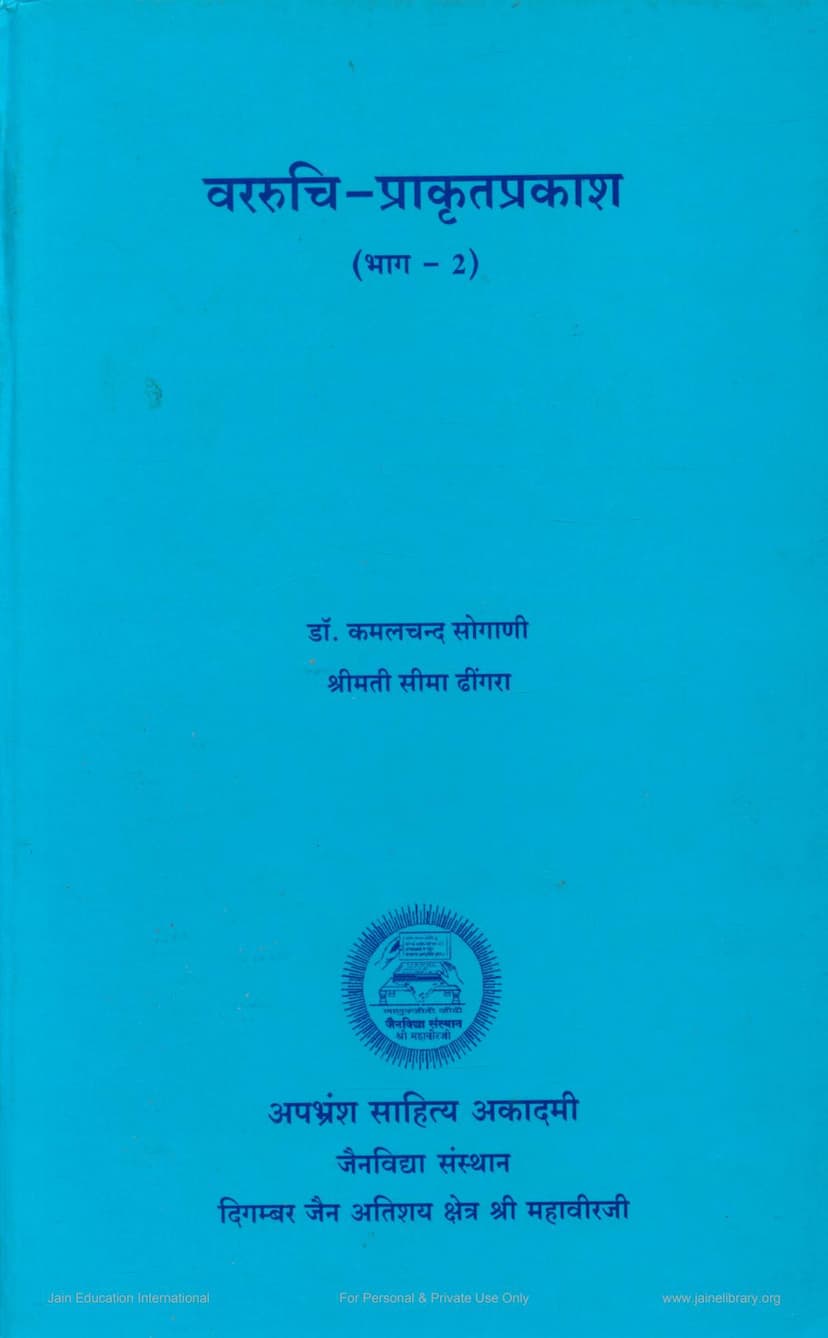Varruchi Prakrit Prakash Part 02
Added to library: September 2, 2025

Summary
This document is the second part of "Varruchi Prakrit Prakash," a book on Prakrit grammar authored by Dr. Kamalchand Sogani and Mrs. Seema Dhingra, published by Apbhramsa Sahitya Academy. This volume specifically focuses on the analysis of verb and participial (kṛdanta) sutras from Varruchi's Prakrit Prakash.
Key aspects covered in the book include:
-
Introduction and Editorial Remarks (Pages 5-9): The initial sections express pleasure in presenting this work to Prakrit students. They highlight Prakrit's significant role in the history of Indian literature and its connection to the evolution of Indo-Aryan languages, considering it the source of Apabhramsha and subsequently modern Indian languages like Hindi. The importance of grammar for understanding and preserving languages, especially the constantly changing nature of language, is emphasized. Varruchi's Prakrit Prakash, composed in Sanskrit in the 3rd-4th century CE, is recognized as a foundational and influential work in Prakrit grammar, with its sutras being highly regarded. This second part delves into the verb and participial sutras within the seventh chapter of Varruchi's work. The authors aim to explain these sutras in a manner accessible to students with basic Sanskrit knowledge. The book also acknowledges the establishment of the Apabhramsha Sahitya Academy under the Jainvidya Sansthan, Sri Mahavirji, and its mission to promote Prakrit and Apabhramsha studies through various publications.
-
Verb Sutra Discussion (Pages 10-15): This section provides a detailed introduction to understanding the verb sutras. It outlines the necessary prerequisite knowledge, including:
- Basic understanding of Sanskrit grammar, particularly sandhi rules (vowel, consonant, and visarga).
- Knowledge of Sanskrit participial affixes and their forms in different tenses, persons, and numbers.
- Understanding of verb conjugation in Prakrit, which includes present, past, and future tenses, as well as imperative and injunctive moods. Prakrit verbs have three persons (first, second, third) and two numbers (singular, plural).
- Recognition of five types of participles: samabandhaka kṛdanta (conjunctive participle), hetvartha kṛdanta (purpose participle), vartamānakālika kṛdanta (present participle), bhūtakālika kṛdanta (past participle), and vidhi kṛdanta (gerundive).
- Understanding of active voice (kartṛvācya), passive voice (karmavācya), and impersonal voice (bhāvavācya), along with their respective affixes.
- Knowledge of causative verb affixes.
The text then lists various Sanskrit verbal affixes for different tenses, persons, and numbers to aid comprehension. It also explains how to understand the declension of words based on their endings (e.g., Hari, Bhūbhr̥t, Gopā, Rāma, Strī, Guru) by referring to Sanskrit grammar. The method of explaining the sutras is detailed: sandhi-viccheda (segmentation), identification of case endings, literal translation, contextual meaning, and examples of usage. The book states that the sutras will help form verb forms for verbs ending in -a, -ā, and -o. A key symbol list is also provided for mathematical signs used in explanations.
-
Analysis of Specific Sutras (Pages 17-34): This is the core of the volume, where individual sutras related to Prakrit verbs and participles are presented and analyzed. Each sutra is broken down with:
- Sutra number and text: (e.g., 7/1, Tatiiporidetau)
- Sandhi breakdown: The sutra is segmented, and the sandhi rules applied are explained.
- Root word and case: The grammatical form of words within the sutra is identified.
- Analogy: References to Sanskrit declension patterns (e.g., Bhūbhr̥t, Hari, Rāma) are given for understanding.
- Explanation: The rule itself is clarified, detailing the changes in affixes or roots in Prakrit.
- Examples: Prakrit verb forms are generated based on the sutra and examples (e.g., hasai, hasase, hasami for present tense).
The sutras cover a wide range of verb conjugations, participial formations, and tense constructions, including:
- Present tense endings.
- The role of 'a', 'e', 'i' in verb endings.
- Formation of future tense.
- Changes in verb roots for specific verbs (like kṛ, dā, vac, gam).
- Formation of passive and impersonal voice.
- Causative verb formations.
- Specific rules for Sauraseni Prakrit are also presented.
-
Appendix 1: Sandhi Rules Used in the Sutras (Pages 33-35): This appendix systematically lists and explains the sandhi (joining of sounds) rules that are frequently employed in the analyzed sutras. It covers vowel sandhi, consonant sandhi, and visarga sandhi with relevant examples from the sutras.
-
Appendix 2: Grammatical Analysis of Sutras (Pages 36-51): This section provides a detailed breakdown of each sutra presented earlier. For each sutra, it lists the sutra number, the sutra text, the sandhi rules involved, and then breaks down the words within the sutra, identifying their root form, case, and providing analogies for their grammatical behavior.
-
Appendix 3: Reference Books and Dictionaries (Page 62): This list provides a bibliography of essential texts for Prakrit studies, including various editions of Prakrit Prakash, Paiya-Sadda-Mahannavo (a Prakrit lexicon), and other relevant grammar books.
In essence, Varruchi Prakrit Prakash Part 02 is a scholarly work that meticulously dissects and explains the grammatical rules governing verbs and participles in Prakrit, based on the seminal work of Varruchi. It serves as a valuable resource for students and researchers of Prakrit language and literature.